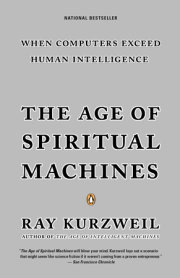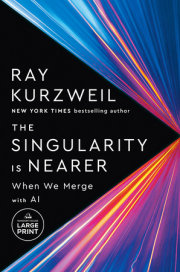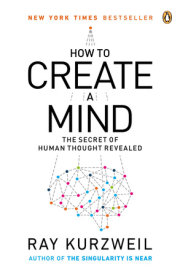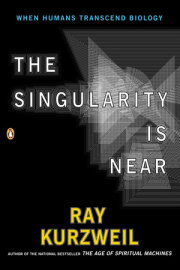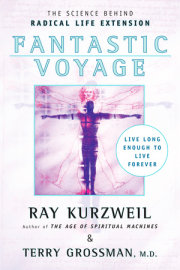A Note to the Reader
Acknowledgments
Prologue: An Inexorable Emergence
Before the next century is over, human beings will no longer be the most intelligent or capable type of entity on the planet. Actually, let me take that back. The truth of that last statement depends on how we define human.
Part One: Probing the Past
Chapter One: The Law of Time and Chaos
For the past forty years, in accordance with Moore's Law, the power of transistor-based computing has been growing exponentially. But by the year 2020, transistor features will be just a few atoms thick, and Moore's Law will have run its course. What then? To answer this critical question, we need to understand the exponential nature of time.
Chapter Two: The Intelligence of Evolution
Can an intelligence create another intelligence more intelligent than itself? Are we more intelligent than the evolutionary process that created us? In turn, will the intelligence that we are creating come to exceed that of its creator?
Chapter Three: Of Mind and Machines
"I am lonely and bored, please keep me company." If your computer displayed this message on its screen, would that convince you that it is conscious and has feelings? Before you say no too quickly, we need to consider how such a plaintive message originated.
Chapter Four: A New Form of Intelligence on Earth
Intelligence rapidly creates satisfying, sometimes surprising plans that meet an array of constraints. Clearly, no simple formula can emulate this most powerful of phenomena. Actually, that's wrong. All that is needed to solve a surprisingly wide range of intelligent problems is exactly this: simple methods combined with heavy doses of computation, itself a simple process.
Chapter Five: Context and Knowledge
It is sensible to remember today's insights for tomorrow's challenges. It is not fruitful to rethink every problem that comes along. This is particularly true for humans, due to the extremely slow speed of our computing circuitry.
Part Two: Preparing the Present
Chapter Six: Building New Brains...
Evolution has found a way around the computational limitations of neural circuitry. Cleverly, it has created organisms who in turn invented a computational technology a million times faster than carbon-based neurons. Ultimately, the computing conducted on extremely slow mammalian neural circuits will be ported to a far more versatile and speedier electronic (and photonic) equivalent.
Chapter Seven: ...And Bodies
A disembodied mind will quickly get depressed. So what kind of bodies will be provide for our twenty-first-century machines? Later on, the question will become: What sort of bodies will they provide for themselves?
Chapter Eight: 1999
If all the computers in 1960 stopped functioning, few people would have noticed. Circa 1999 is another matter. Although computers still lack a sense of humor, a gift for small talk, and other endearing qualities of human thought, they are nonetheless mastering an increasingly diverse array of tasks that previously required human intelligence.
Part Three: To Face the Future
Chapter Nine: 2009
It is now 2009. A $1,000 personal computer can perform about a trillion calculations per second. Computers are imbedded in clothing and jewelry. Most routine business transactions take place between a human and a virtual personality. Translating telephones are commonly used. Human musicians routinely jam with cybernetic musicians. The neo-Luddite movement is growing.
Chapter Ten: 2019
A $1,000 computing device is now approximately equal to the computational ability of the human brain. Computers are now largely invisible and are embedded everywhere. Three-dimensional virtual-reality displays, embedded in glasses and contact lenses, provide the primary interface for communication with other persons, the Web, and virtual reality. Most interaction with computing is through gestures and two-way natural-language spoken communication. Realistic all-encompassing visual, auditory, and tactile environments enable people to do virtually anything with anybody, regardless of physical proximity. People are beginning to have relationships with automated personalities as companions, teachers, caretakers, and lovers.
Chapter Eleven: 2029
A $1,000 unit of computation has the computing capacity of approximately one thousand human brains. Direct neural pathways have been perfected for high-bandwidth connection to the human brain. A range of neural implants is becoming available to enhance visual and auditory perception and interpretation, memory, and reasoning. Computers have read all available human- and machine-generated literature and multimedia material. There is growing discussion about the legal rights of computers and what constitutes being human. Machines claim to be conscious and these claims are largely accepted.
Chapter Twelve: 2099
There is a strong trend toward a merger of human thinking with the world of machine intelligence that the human species initially created. There is no longer any clear distinction between humans and computers. Most conscious entities do not have a permanent physical presence. Machine-based intelligences derived from extended models of human intelligence claim to be human. Most of these intelligences are not tied to a specific computational processing unit. The number of software-based humans vastly exceeds those still using native neuron-cell-based computation. Even among those human intelligences still using carbon-based neurons, there is ubiqutous use of neural-implant technology that provides enormous augmentation of human perceptual and cognitive abilities. Humans who do not utilize such implants are unable to meaningfully participate in dialogues with those who do. Life expectancy is no longer a viable term in relation to intelligent beings.
Epilogue: The Rest of the Universe Revisited
Intelligent beings consider the fate of the universe.
Time Line
How to Build an Intelligent Machine in Three Easy Paradigms
Glossary
Notes
Suggested Readings
Web Links
Index



